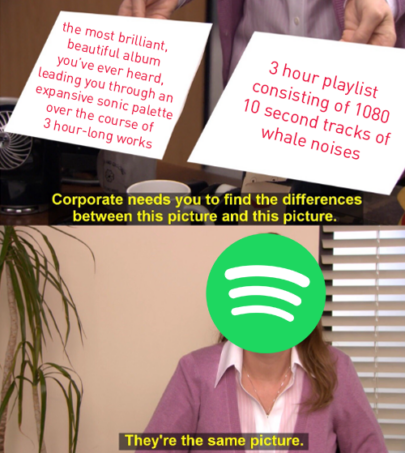
Late last year, Spotify announced that their royalty payment model was to undergo drastic changes in 2024, and as of the start of April these changes have now been implemented. This comes with the potential industry shake-up provided by Vault.fm (which some would argue is very similar to already existing services like Patreon and Ko-fi) which seeks to pay artists more fairly.
The most impactful of their policy changes are the required threshold of tracks needing 1,000 streams in the preceding 12 months to be added to the royalty pool, and a minimum of unique listeners – which they will keep private to help prevent manipulation. We know that it is easy to spot most artificial streams, as many of the paid services that offer streams for money often are obvious. And if it’s obvious to us, it is VERY obvious to Spotify, who will have more data than what is available to us. They have specifically said the policy changes are to stop “further manipulation by bad actors”, meaning that playlisting is looking like the only viable paid-for method to boost your streams.
Playlisting is a tried and trusted method to increase streams from relevant people who may be interested in more of your releases, and a long-term listener is far more valuable than a fake stream. The playlisting can be from a store, streaming platform or independent curator who creates their own list of songs specified to a certain genre or mood, some of which are followed by millions of people. This exposes music to new listeners, boosting streams, downloads and purchases, as many people turn to popular playlists as a place to discover new music – us included.
Although streaming is not a viable source of income, especially for those within a niche, it is a valuable tool for promotion. For example, if a festival were to release recordings of performances, each release on a streaming platform is an opportunity to spread awareness and recognition, which could see a benefit to ticket sales the following year. There are also multiple opportunities to use streaming platforms to advertise physical products and concerts, which can then allow you to make more income from music. This is an often neglected part of strategy, particularly in classical music, and is one of a few simple ideas on how to stay ahead.
As Spotify has the largest market share for streaming platforms, these changes apply to all musicians, and means there is more reason to pay attention to your release and streaming strategy than ever. If you’re COMPLETELY new to playlisting, we’ve put our Playlisting FAQs down below!
—
Playlisting FAQs
When should I think about playlisting?
For editorial playlisting, this depends on the platform. We would recommend speaking to us about editorial playlisting at least 6 to 4 weeks before your album release for full pitching possibilities, but you can still speak to us at least a week before, which allows us to pitch to other editors.
For user playlisting, your music must already be released. Most editors value recent releases most, so we recommend speaking to us within 6 months of the release, but we have seen some success with back catalogues older than this.
How do we work?
Whether you’d like editorial playlisting or user playlisting, speak to us about what music you’d like us to pitch – context is key, so we want to know your goals, dreams, and the story of both the music and its maker.
We combine these factors with our knowledge and experience to determine which editors and curators your music is most compatible with. Then, we formulate the best pathway for growth and make the connections accordingly.
Why is playlisting effective?
Playlisting can generate income from streams, as they are an organic and streaming platform-approved method of gaining streams. We notice some accounts that pay for bot streams, which will obviously get the short-term effect of boosting streaming numbers, but this can often lead to being blacklisted by streaming platforms, which can detect bots.
As well as the safe, passive income that being on a successful playlist can give you, it also gives you an opportunity to expand your listeners. Many of the playlists we regularly get placements on have half a million or more likes, in ones curated by streaming platforms, as well as user curators.
Why WildKat?
Having built relationships with the editors at the most popular DSPs (digital service providers), we are confident that we will always get you listened to and in consideration for editorial playlisting. This is beyond the self-submissions and a direct in with the editors that cover specific playlists that are valuable to you.
We also have built up a database full of user playlists that we pitch to. Although not as prestigious as the editorial playlists, getting on several of these types can have the same cumulative effect on your streaming numbers. We make sure to match your music to the right playlist, making these streams much more valuable.
We use our experience and knowledge of these playlists, as well as specialised platforms to submit your music to, to ensure your music is sent to the right place.
Get in touch with us by email, phone or drop by one of our offices, and we’d be happy to discuss options and approaches to meet your goals.
 BACK
BACK